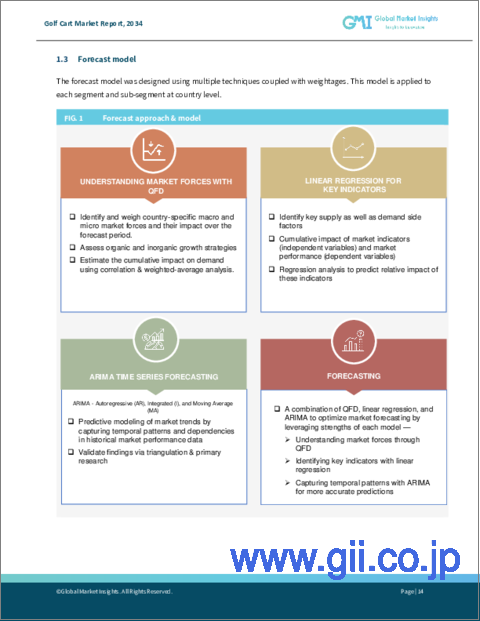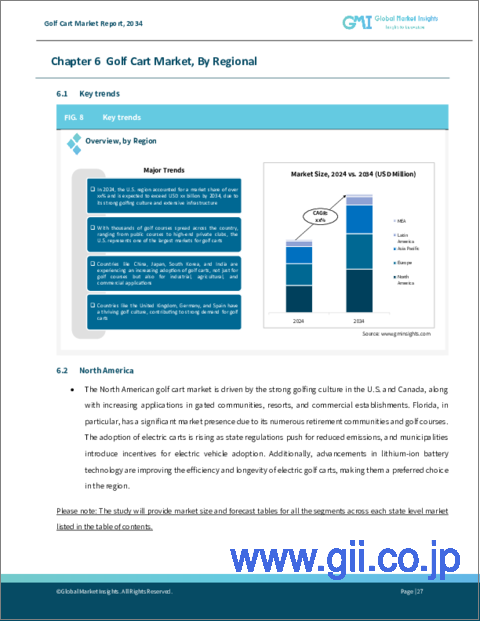|
|
市場調査レポート
商品コード
1666577
ゴルフカートの市場機会、成長促進要因、産業動向分析、2025年~2034年予測Golf Cart Market Opportunity, Growth Drivers, Industry Trend Analysis, and Forecast 2025 - 2034 |
||||||
カスタマイズ可能
|
|||||||
| ゴルフカートの市場機会、成長促進要因、産業動向分析、2025年~2034年予測 |
|
出版日: 2024年12月19日
発行: Global Market Insights Inc.
ページ情報: 英文 240 Pages
納期: 2~3営業日
|
全表示
- 概要
- 目次
ゴルフカートの世界市場は2024年に26億米ドルと評価され、有望な軌道に乗っており、2025年から2034年までのCAGRは8%と堅調な予測となっています。
特に新興国市場では、レジャーとしても競合スポーツとしてもゴルフの人気が高まっており、これが市場拡大の主な要因となっています。ゴルフを始める人が増え、レクリエーション施設が増え続けるにつれて、ゴルフカートの需要が急増しています。こうした多用途の乗り物はゴルフ体験を大幅に向上させ、あらゆる年齢層のゴルファーに利便性、効率性、アクセス性を提供します。この動向は、屋外レクリエーション活動において環境に優しい代替手段を求める広範なシフトにも支えられています。

ゴルフ場だけでなく、住宅地やリゾート地、さらには空港でもゴルフカートの利用が増加しており、市場をさらに活性化しています。特に、電動モデルは利便性が高いため、人気の高い選択肢となっています。さらに、バッテリー寿命、充電インフラ、車両設計の技術的進歩により、機能性と魅力が絶えず向上しています。ゴルフカートは今や、コースでの移動手段だけでなく、さまざまな分野で日常生活の一部として捉えられています。その結果、メーカー各社は、より環境に優しく、より効率的で、費用対効果の高いソリューションを求める消費者の要求に応えるべく、積極的な技術革新に取り組んでいます。
| 市場範囲 | |
|---|---|
| 開始年 | 2024年 |
| 予測年 | 2025年~2034年 |
| 開始金額 | 26億米ドル |
| 予測金額 | 57億米ドル |
| CAGR | 8% |
市場は燃料タイプ別に区分され、ガソリンカート、電動カート、ソーラーカートがあります。2024年現在、電動ゴルフカート分野が63%のシェアを占め、市場をリードしています。この分野は、持続可能性へのシフトの高まりと消費者の環境意識の高まりによって、2034年までに36億米ドルに達すると予想されています。電動カートは充電式バッテリーを動力源とし、環境汚染物質を排出しない環境に優しい特性が評価され、環境意識の高いゴルファーの選好に合致しています。これらのカートは、ゴルフ場、住宅地、観光地など、低メンテナンスと静かな運転が重要な用途に理想的です。
用途別では、ゴルフ場向けが2024年に53%のシェアを占め、最大となりました。ゴルフカートはコースで欠かせないもので、プレーヤーや用具を広大なエリアに運ぶなど、必要不可欠なサービスを提供しています。特に、移動に課題のある人にとって有益で、ゲームを十分に楽しむことができます。プレーヤーの移動だけでなく、ゴルフカートはメンテナンス、造園、用具の移動など、コースのさまざまな運営ニーズにも欠かせないもので、管理の合理化とコース全体の効率向上に役立っています。
米国のゴルフカート市場は引き続き最大手で、2024年には市場シェアの95%を占めました。2034年までに米国市場は32億米ドルを生み出すと予想されています。この成長の原動力となっているのは、同国の根強いゴルフ文化、ゴルフコースの普及、住宅地、老人村、空港、リゾート地などコース外でのゴルフカートの普及です。米国は依然として市場動向の重要な促進要因であり、この分野の継続的な成長と革新の舞台となっています。
目次
第1章 調査手法と調査範囲
- 調査デザイン
- 調査アプローチ
- データ収集方法
- 基本推定と計算
- 基準年の算出
- 市場推計の主要動向
- 予測モデル
- 一次調査と検証
- 一次ソース
- データマイニングソース
- 市場定義
第2章 エグゼクティブサマリー
第3章 業界洞察
- 業界エコシステム分析
- 技術プロバイダー
- 部品サプライヤー
- メーカー
- OEMメーカー
- サプライヤーの状況
- 利益率分析
- 技術革新の状況
- 主要ニュース・イニシアチブ
- 規制状況
- 影響要因
- 成長促進要因
- ゴルフとレジャーの人気の高まり
- ゴルフ場以外への用途拡大
- 環境に優しい電気自動車への需要の高まり
- 都市化とインフラ開発の増加
- 業界の潜在的リスク・課題
- 先進モデルの初期コストが高い
- 限られたバッテリー性能と充電インフラ
- 成長促進要因
- 成長可能性分析
- ポーター分析
- PESTEL分析
第4章 競合情勢
- イントロダクション
- 企業市場シェア分析
- 競合のポジショニングマトリックス
- 戦略展望マトリックス
第5章 市場推計・予測:燃料別、2021年~2034年
- 主要動向
- ガソリン
- 電気
- ソーラー
第6章 市場推計・予測:用途別、2021年~2034年
- 主要動向
- ゴルフ場
- 商業サービス
- PTV/SLV
第7章 市場推計・予測:座席数別、2021年~2034年
- 主要動向
- 2シーター
- 4シーター
- 6シーター
- その他
第8章 市場推計・予測:地域別、2021年~2034年
- 主要動向
- 北米
- 米国
- カナダ
- 欧州
- 英国
- ドイツ
- フランス
- スペイン
- イタリア
- ロシア
- 北欧
- アジア太平洋
- 中国
- インド
- 日本
- 韓国
- ニュージーランド
- 東南アジア
- ラテンアメリカ
- ブラジル
- メキシコ
- アルゼンチン
- 中東・アフリカ
- UAE
- 南アフリカ
- サウジアラビア
第9章 企業プロファイル
- Yamaha
- Club Car
- EZ-GO
- Guangdong Lvtong New Energy Electric Vehicle Technology Co., LTD.
- Marshell Green Power Co. Ltd
- Suzhou Eagle Electric Vehicle Manufacturing Co., Ltd
- GUANGZHOU LANGQING ELECTRIC CAR CO., LTD.
- Garia Inc.
- Polaris Industries Inc.
- STAR EV Corporation
- HDK Electric Vehicle
- Columbia Vehicle Group Inc.
- Cushman(A subsidiary of Textron Inc.)
- Tomberlin(A Polaris Company)
- JH Global Services Inc.(Star EV)
The Global Golf Cart Market, valued at USD 2.6 billion in 2024, is on a promising trajectory, with projections indicating a robust CAGR of 8% from 2025 to 2034. The increasing popularity of golf as both a leisure activity and competitive sport, especially in developed regions, is a major driver of this market's expansion. As more people take up the sport and recreational facilities continue to grow, the demand for golf carts has surged. These versatile vehicles significantly enhance the golfing experience, offering convenience, efficiency, and accessibility to golfers of all ages. The trend is also supported by a broader shift toward eco-friendly alternatives in outdoor recreational activities.

Beyond golf courses, the growing use of golf carts in residential areas, resorts, and even airports further fuels the market. The convenience of electric-powered models, in particular, makes them a popular choice. Moreover, technological advancements in battery life, charging infrastructure, and vehicle design are continually enhancing their functionality and appeal. Golf carts are now viewed as not just a mode of transport on the course, but as a part of daily life in various sectors. As a result, manufacturers are actively innovating to meet evolving consumer demands for greener, more efficient, and cost-effective solutions.
| Market Scope | |
|---|---|
| Start Year | 2024 |
| Forecast Year | 2025-2034 |
| Start Value | $2.6 Billion |
| Forecast Value | $5.7 Billion |
| CAGR | 8% |
The market is segmented by fuel type, with gasoline, electric, and solar-powered carts. As of 2024, the electric golf cart segment leads the market, holding a 63% share. This segment is expected to reach USD 3.6 billion by 2034, driven by the growing shift towards sustainability and the increasing environmental consciousness of consumers. Electric carts are powered by rechargeable batteries and are celebrated for their eco-friendly attributes, emitting no pollutants, which aligns with the preferences of environmentally conscious golfers. These carts are ideal for applications where low maintenance and quiet operation are key, including golf courses, residential communities, and tourist destinations.
In terms of application, the golf course segment took the largest share in 2024, holding 53%. Golf carts are indispensable on courses, offering essential services such as transporting players and equipment across expansive areas. They are especially beneficial for individuals with mobility challenges, allowing them to fully enjoy the game. Beyond player transport, golf carts are also essential for various operational needs on the course, such as maintenance, landscaping, and equipment transfer, helping to streamline management and improve overall course efficiency.
The U.S. golf cart market continues to be the largest player, accounting for 95% of the market share in 2024. By 2034, the U.S. market is expected to generate USD 3.2 billion. This growth is driven by the country's strong golfing culture, the widespread availability of golf courses, and the increasing adoption of golf carts beyond the course, such as in residential communities, retirement villages, airports, and resorts. The U.S. remains a key driver of market trends, setting the stage for continued growth and innovation in the sector.
Table of Contents
Chapter 1 Methodology & Scope
- 1.1 Research design
- 1.1.1 Research approach
- 1.1.2 Data collection methods
- 1.2 Base estimates and calculations
- 1.2.1 Base year calculation
- 1.2.2 Key trends for market estimates
- 1.3 Forecast model
- 1.4 Primary research & validation
- 1.4.1 Primary sources
- 1.4.2 Data mining sources
- 1.5 Market definitions
Chapter 2 Executive Summary
- 2.1 Industry synopsis, 2021 - 2034
Chapter 3 Industry Insights
- 3.1 Industry ecosystem analysis
- 3.1.1 Technology providers
- 3.1.2 Component suppliers
- 3.1.3 Manufacturers
- 3.1.4 OEMs
- 3.2 Supplier landscape
- 3.3 Profit margin analysis
- 3.4 Technology & innovation landscape
- 3.5 Key news & initiatives
- 3.6 Regulatory landscape
- 3.7 Impact forces
- 3.7.1 Growth drivers
- 3.7.1.1 Growing popularity of golf and leisure activities
- 3.7.1.2 Expanding applications beyond golf courses
- 3.7.1.3 Rising demand for eco-friendly and electric vehicles
- 3.7.1.4 Increasing urbanization and infrastructure development
- 3.7.2 Industry pitfalls & challenges
- 3.7.2.1 High initial costs for advanced models
- 3.7.2.2 Limited battery performance and charging infrastructure
- 3.7.1 Growth drivers
- 3.8 Growth potential analysis
- 3.9 Porter’s analysis
- 3.10 PESTEL analysis
Chapter 4 Competitive Landscape, 2024
- 4.1 Introduction
- 4.2 Company market share analysis
- 4.3 Competitive positioning matrix
- 4.4 Strategic outlook matrix
Chapter 5 Market Estimates & Forecast, By Fuel, 2021 - 2034 ($Bn, Units)
- 5.1 Key trends
- 5.2 Gasoline
- 5.3 Electric
- 5.4 Solar-powered
Chapter 6 Market Estimates & Forecast, By Application, 2021 - 2034 ($Bn, Units)
- 6.1 Key trends
- 6.2 Golf courses
- 6.3 Commercial services
- 6.4 PTV/SLV
Chapter 7 Market Estimates & Forecast, By Seating Capacity, 2021 - 2034 ($Bn, Units)
- 7.1 Key trends
- 7.2 2-Seater
- 7.3 4-Seater
- 7.4 6-Seater
- 7.5 Others
Chapter 8 Market Estimates & Forecast, By Region, 2021 - 2034 ($Bn, Units)
- 8.1 Key trends
- 8.2 North America
- 8.2.1 U.S.
- 8.2.2 Canada
- 8.3 Europe
- 8.3.1 UK
- 8.3.2 Germany
- 8.3.3 France
- 8.3.4 Spain
- 8.3.5 Italy
- 8.3.6 Russia
- 8.3.7 Nordics
- 8.4 Asia Pacific
- 8.4.1 China
- 8.4.2 India
- 8.4.3 Japan
- 8.4.4 South Korea
- 8.4.5 ANZ
- 8.4.6 Southeast Asia
- 8.5 Latin America
- 8.5.1 Brazil
- 8.5.2 Mexico
- 8.5.3 Argentina
- 8.6 MEA
- 8.6.1 UAE
- 8.6.2 South Africa
- 8.6.3 Saudi Arabia
Chapter 9 Company Profiles
- 9.1 Yamaha
- 9.2 Club Car
- 9.3 EZ-GO
- 9.4 Guangdong Lvtong New Energy Electric Vehicle Technology Co., LTD.
- 9.5 Marshell Green Power Co. Ltd
- 9.6 Suzhou Eagle Electric Vehicle Manufacturing Co., Ltd
- 9.7 GUANGZHOU LANGQING ELECTRIC CAR CO., LTD.
- 9.8 Garia Inc.
- 9.9 Polaris Industries Inc.
- 9.10 STAR EV Corporation
- 9.11 HDK Electric Vehicle
- 9.12 Columbia Vehicle Group Inc.
- 9.13 Cushman (A subsidiary of Textron Inc.)
- 9.14 Tomberlin (A Polaris Company)
- 9.15 JH Global Services Inc. (Star EV)






